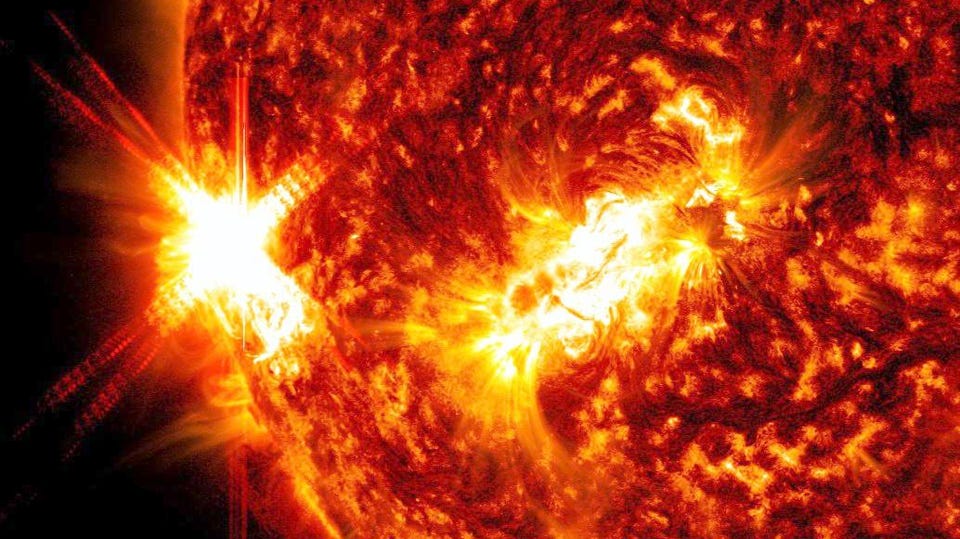The Sun Is Suddenly Spitting ‘X-Class’ Flares At Us. Why It’s Happening And What It Means


NASA’s Solar Dynamics Observatory captured this image of a solar flare – as seen in the bright flash … [+] on the left side of the image – on Jan. 9, 2023. The image shows a subset of extreme ultraviolet light that highlights the extremely hot material in flares and is colorized in red and gold.
NASA/SDO
The Sun has woken up. The beginning of 2023 has seen our star crackle with activity, with observers seeing black sunspots all over its surface as it waxes towards possibly one of its strongest periods on record.
The resulting “X-class” solar flares can affect Earth’s magnetic field with the potential to damage satellites and communications equipment as well as casing power grids to overload. Solar flares are also a threat to orbiting astronauts.
MORE FROM FORBESWhy You Need To See The Northern Lights In 2023 (And Where To Go)By Jamie Carter
A ball of hydrogen and helium gas about 93 million miles from Earth, the Sun has a roughly 11 year solar cycle. During that time it moves from a period of “solar minimum” to a “solar maximum.” The latter—the peak of the current Solar Cycle 25—is expected to occur in 2024 or 2025, making this year theoretically one of the most powerful periods for the Sun for almost a decade.
The evidence is suddenly everywhere as “space weather” increases. After more sunspots appeared on its surface last week our star issued three solar flares of the strongest type possible — so-called X-flares. That was on the back of one of its most active days for years in December 2022. On January 5, 9 and 10, respectively, X1-class solar flares erupted from sunspots, sending pulses of x-rays and extreme ultraviolet radiation out into the solar system traveling at light-speed, some of it in the direction of Earth.

An active region on the Sun captured in extreme ultraviolet light from NASA’s Solar Dynamic … [+] Observatory (SDO) spacecraft.
NASA via Getty Images
Since then there have been a number of less intense M-class solar flares with a chance of more X-class flares in the coming days.
Solar flares—which can cause radio blackouts on Earth minutes after occurring—are eruptions of electromagnetic radiation in the Sun’s atmosphere. They’re caused by twisted magnetic fields, typically above sunspots—cooler, darker regions of the Sun’s surface that form when clumps of its magnetic field well up from deep within the Sun. Sunspots appear in solar telescopes as as tiny specks on the Sun’s surface, but they can be colossal in size. Their frequency is the main clue solar physicists have in gauging how intense (or otherwise) solar activity is and, right now, they’re everywhere. In fact, if sunspot production continues at this rate for the rest of January the monthly sunspot number will reach a 20-year high, according to Spaceweather.com.
So far Solar Cycle 25 has been known for producing sunspots on the Sun’s far side, but the Jan. 9 event’s extreme ultraviolet flash was captured by NASA’s Solar Dynamics Observatory (SDO) (main image, above). It caused a shortwave radio blackout in the Pacific Ocean.
While the effects of solar flares on Earth can be sudden, it’s what can often happen next that are more noticeable. From sunspots and solar flares can come coronal mass ejections (CMEs), large expulsions of plasma and magnetic field from the Sun’s corona that can take 15-18 hours to reach Earth (although they can be aimed anywhere in the solar system). When a CME arrives at Earth it can cause geomagnetic storms, a significant disturbances in Earth’s magnetic field.
Forecasters at the NOAA (National Oceanic and Atmospheric Administration) Space Weather Prediction Center predict that an M-class solar flare and CME on Jan. 14 could cause a geomagnetic storm on Jan. 19.
That means intense Northern Lights could be on the way.

The northern lights over Villingaholtskirkja Church on the south coast of Iceland. Picture date: … [+] Sunday November 27, 2022. (Photo by Owen Humphreys/PA Images via Getty Images)
PA Images via Getty Images
One result could be more intense and frequent aurora. When a CME comes our way, Earth’s magnetosphere accelerates the charged particles down its field lines to the poles. The result is brighter and more frequent are the displays of the Northern Lights and the Southern Lights.
While the Arctic and Antarctic Circles are typically the best places to view aurora, during an intense geomagnetic storm the “auroral oval” increases in size so people who live in areas that normally don’t experience aurora—such as the USA and Western Europe—sometimes get to see them. And it’s right now, as we approach solar maximum, that aurora are at their most frequent and spectacular.
Wishing you clear skies and wide eyes.
